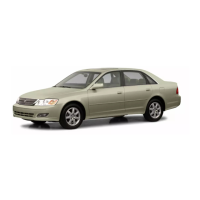6008V–02
–SUPPLEMENTAL RESTRAINT SYSTEM SUPPLEMENTAL RESTRAINT SYSTEM
60–1
2384Author: Date:
SUPPLEMENTAL RESTRAINT SYSTEM
PRECAUTION
CAUTION:
The CAMRY is equipped with SRS, which comprises a driver airbag, front passenger airbag,
side airbag and curtain shield airbag. Failure to carry out service operations in the correct se-
quence could cause the SRS to unexpectedly deploy during servicing, possibly leading to a
serious accident. Further, if a mistake is made in servicing the SRS, it is possible that the SRS
may fail to operate when required. Before performing servicing (including removal or installa-
tion of parts, inspection or replacement), be sure to read the following items carefully, then fol-
low the correct procedures described in the repair manual.
Work must be started 90 seconds after the ignition switch is turned to the ”LOCK” position and
the negative (–) terminal cable is disconnected from the battery.
(The SRS is equipped with a back–up power source so that if work is started within 90 seconds
from disconnecting the negative (–) terminal cable of the battery, the SRS may be deployed.)
Do not expose the horn button assy, instr pnl pass l/door airbag assy, airbag sensor assy cen-
ter, airbag front sensor, front seat airbag assy, side airbag sensor assy, curtain shield airbag
assy, airbag sensor rear or seat position airbag sensor directly to hot air or flames.
NOTICE:
Malfunction symptoms of the SRS are difficult to confirm, so the DTCs become the most impor-
tant source of information when troubleshooting. When troubleshooting the SRS, always in-
spect the DTCs before disconnecting the battery.
Even in cases of a minor collision where the SRS does not deploy, the horn button assy, instr
pnl pass l/door airbag assy, airbag sensor assy center, airbag front sensor, front seat airbag
assy, side airbag sensor assy, curtain shield airbag assy, airbag sensor rear and seat position
airbag sensor should be inspected (See page 60–9).
Before repairs, remove the airbag sensor if shocks are likely to be applied to the sensor during
repairs.
Never use SRS parts from another vehicle. When replacing parts, replace them with new parts.
Never disassemble and repair the horn button assy, instr pnl pass l/door airbag assy, airbag
sensor assy center, airbag front sensor, front seat airbag assy, side airbag sensor assy, curtain
shield airbag assy or seat position airbag sensor in order to reuse it.
If the horn button assy, instr pnl pass l/door airbag assy, airbag sensor assy center, airbag front
sensor, front seat airbag assy, side airbag sensor assy, curtain shield airbag assy or seat posi-
tion airbag sensor has been dropped, or if there are cracks, dents or other defects in the case,
bracket or connector, replace it with new one.
Use a volt/ohmmeter with high impedance (10 kΩ/V minimum) for troubleshooting the system’s
electrical circuits.
Information labels are attached to the periphery of the SRS components. Follow the instruc-
tions on the notices.
After work on the SRS is completed, perform the SRS warning light check (See page 05–691).
When the negative (–) terminal cable is disconnected from the battery, the memory of the clock
and audio system will be canceled. So before starting work, make a record of the contents mem-
orized in the audio memory system. When work is finished, reset the audio systems as they
were before and adjust the clock. To avoid erasing the memory in each memory system, never
use a back–up power supply from outside the vehicle.
If the vehicle is equipped with a mobile communication system, refer to the precaution in the
INTRODUCTION section.

